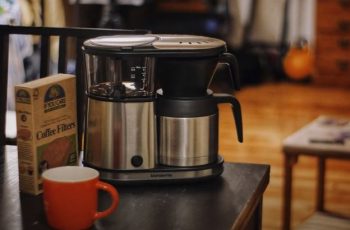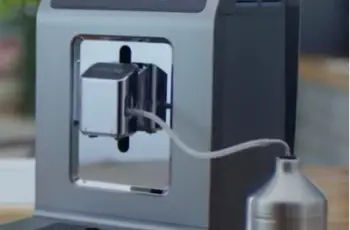Chances are you don’t clean your coffee maker as often as you should. In fact, 50% of these household machines contain yeast and mold, according to one survey. That makes it more germ-infested than your average bathroom faucet handle. To make sure you don’t drink up any of the germs or coliform bacteria this appliance has been known to grow, we asked Carolyn Forte, director of the Good Housekeeping Institute Home Appliances & Cleaning Lab, how to keep your machine clean and your coffee tasting great.
If you are a regular coffee drinker, you need a warm cup of your favorite java in your hand to get your day off to a great start. Many people simply let their coffee machine automatically turn off after a few hours, and they place the pot in the dishwasher. While running the coffee pot and other removable components in the dishwasher is an effective way to sanitize them, other parts of the machine require attention. Deep cleaning the coffee maker with vinegar periodically is one way to do this, but it may not be the best option available.
Why You Need to Clean Your Coffee Maker Regularly
As the coffee filters through your machine each day, it leaves behind a residue that accumulates dramatically over time. Most of this residue is a natural oil from the coffee beans. When this residue is not removed regularly through deep cleaning, it will make your coffee taste increasingly bitter. More than that, the typical coffee maker may be home to dozens of different strains of bacteria as well as yeast and mold. These elements are ingested by you with each sip of coffee. Some can make you sick, and others may find a home in your colon. Cleaning your coffee maker at least every month is essential for optimal health benefits and to keep your coffee tasting great. Find out how having a clean home is essential for health.
The Basics of Coffee Maker
Coffee machine manufacturers have been honing and perfecting their designs for over 30 years. They strive to make their coffee brewers as straightforward and easy to use as possible. Coffee machines, as the name suggests, are household appliances that are used to brew coffee. There are many different models and types of coffee machines available today, and each one uses a different brewing principle.
However, the more common machines use a similar principle of placing ground coffee onto a metal or paper filter within a funnel. This is then sent over a coffee pot that is made from glass or ceramic. When you remove the top of your coffee machine, you will notice three main features:
A reservoir houses the water that you pour into the device at the start of the coffee brewing process. There is also a hole at the bottom of the bucket that a tube moves through. A white tube leads upward from below the base of the reservoir. This tube carries hot water up toward the drip area. Finally, there is a type of shower head to which water arrives from the white tube. The water then escapes the shower head and is sprayed over the ground coffee. In some coffee machines, the water escapes from the tube itself, rather than the showerhead, onto a perforated disc known as the drip area.
How To Clean Mold Out Of a Coffee Maker
Most standard modern coffee makers are prone to numerous issues that can negatively influence the coffee’s flavor. Dust, mold, and other contaminants can accumulate inside hard-to-reach places and can pollute your coffee. Because the nature of coffee makers makes them always subject to moisture, they are the ideal breeding ground for mold to grow and live. Having a moldy coffee maker does not mean that you need to go out and buy a new one. However, the mold can be challenging to eradicate depending on the model of your machine and how long it has been moldy.
Here are some steps to follow to remove mold from your coffee machine:
Step 1: Remove and wash any detachable components of your coffee maker. For most models, this includes the filter tray, as well as any reusable filters. To clean them, use some dish detergent and a cloth to scrub down the individual components.
Step 2: Wipe down the outer parts of your coffee machine with the cloth and dish detergent. Make sure that there are no mold spores or dust on the machine’s exterior. If you can scrub inside of the water reservoir, too. Keep in mind that specific models do not have a large enough reservoir to accommodate this.
Step 3: Fill the coffee pot with half white vinegar and half water, then place the filter back inside of the coffee machine. Note that you do not need to put another filter into the tray.
Step 4: Pour the vinegar and water solution into the coffee machine’s water reservoir, and then place the pot into the machine. Set it to brew to allow the solution to run through the coffee machine. Once the brewing cycle has been completed, allow the solution to sit in the coffee pot for about 10 minutes.
Step 5: Pour the solution out of the coffee pot. Make sure you rinse the coffee pot with clear water before you make coffee to ensure that there is no more vinegar and water solution inside the pot.
Tips For Using Your Coffee Machine
You can do some things to make sure that you are getting the best possible cup of coffee every time. The first, and most important, is to keep your coffee maker clean. The second is to always use a medium grind. Most auto-drip coffee machines were designed to be used with a medium grind, though the optimal grind may vary. Lastly, always brew a full pot, regardless of how many cups of coffee you plan on pouring. Your coffee machine’s reservoir and brew basket are manufactured to accommodate the machine’s maximum capacity. Anything less will cause the machine to run inefficiently.
Final Thoughts
We’ve learned that cleaning your coffee machine of mold is not as gross as it sounds. Follow the steps above, and your coffee machine will be in tip-top shape in no time. These cleaning methods each have unique benefits, and they all are effective at cleaning your coffee maker in different ways. With so many great options to consider, you no longer need to fill your home with the strong smell of vinegar to enjoy the benefits of a clean coffee maker.


